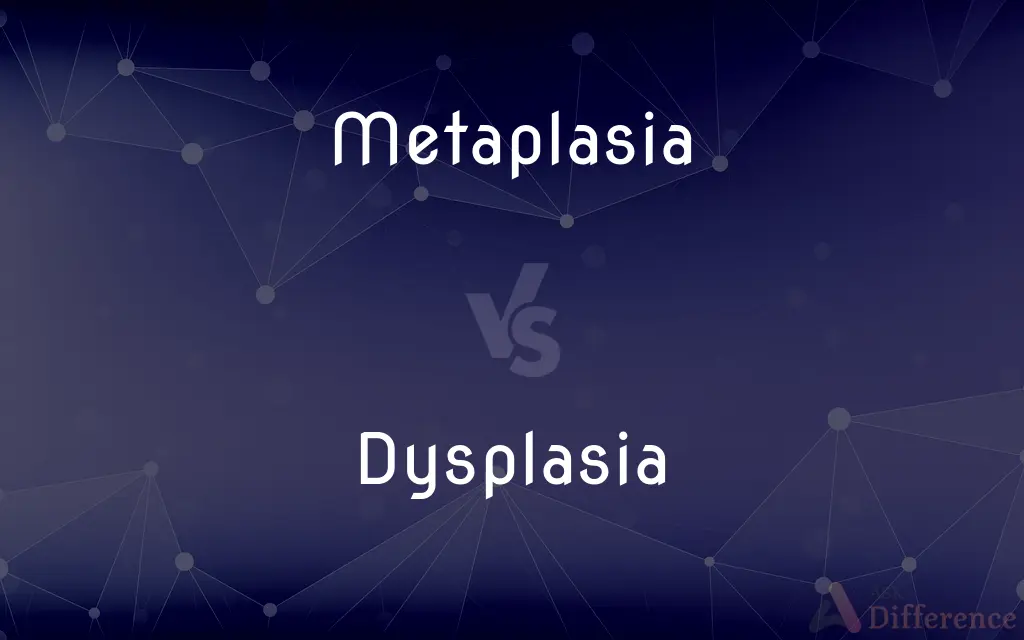Metaplasia vs. Dysplasia — What's the Difference?
Edited by Tayyaba Rehman — By Fiza Rafique — Updated on October 5, 2023
Metaplasia is the benign change of one cell type to another within tissue, while Dysplasia involves abnormal cell growth that can precede cancer.

Difference Between Metaplasia and Dysplasia
Table of Contents
ADVERTISEMENT
Key Differences
Metaplasia and Dysplasia are both types of cellular changes that can occur within tissues. Metaplasia is characterized by a benign change from one type of mature cell to another. It is a reversible and adaptive response to environmental stimuli. On the other hand, Dysplasia is the presence of abnormal cells within a tissue. It denotes an increase in immature or undifferentiated cells and often suggests a precancerous state.
While Metaplasia is not precancerous by itself, persistent stimuli leading to chronic Metaplasia can increase the risk of Dysplasia. Dysplasia, on the other hand, is considered a precancerous change, with a potential to progress to cancer if not addressed.
The causes of Metaplasia usually revolve around persistent irritation or inflammation, causing one type of cell to transform into another more suited for the environment. Dysplasia can arise from prolonged Metaplasia or from genetic mutations and other factors that disrupt normal cell growth.
Metaplasia is generally reversible if the causative factor is removed. Dysplasia can also be reversible, especially in its early stages, but it carries a higher risk of progressing to an irreversible cancerous state.
Both Metaplasia and Dysplasia can be diagnosed through histological examination of biopsy samples. While Metaplasia might not require intervention other than removing the causative agent, Dysplasia often requires more aggressive treatment due to its potential to become malignant.
ADVERTISEMENT
Comparison Chart
Definition
Benign change of one cell type to another.
Abnormal growth and variety in cell size, shape, or organization.
Relevance to Cancer
Not precancerous, but can lead to Dysplasia.
Precancerous, can lead to cancer.
Causes
Chronic irritation or inflammation.
Genetic mutations, prolonged Metaplasia, etc.
Reversibility
Typically reversible upon removal of stimulus.
Can be reversible, but high risk of progressing to cancer.
Appearance Under Microscope
Change in cell type without abnormal architecture.
Disorganized growth, variability in cell size and shape.
Compare with Definitions
Metaplasia
A reversible cellular adaptation due to environmental changes.
Chronic acid reflux can cause Metaplasia in the esophagus.
Dysplasia
Anomalous cell growth suggesting a precancerous state.
His biopsy showed evidence of Dysplasia, requiring further investigation.
Metaplasia
Benign transformation of one cell type to another within tissue.
In response to smoke, bronchial epithelium can undergo Metaplasia.
Dysplasia
A pathology indicating disturbed cell maturation and differentiation.
Dysplasia in the colon raises concerns about future cancer risk.
Metaplasia
Cellular response aiming to better endure adverse conditions.
Metaplasia is a protective mechanism against injurious stimuli.
Dysplasia
A term describing cells that don't appear normal, but aren't yet cancer.
She underwent surgery to remove areas of cervical Dysplasia.
Metaplasia
A phenomenon seen in various tissues when under chronic stress.
Cervical Metaplasia can be observed in some pap smear results.
Dysplasia
Aberrant development seen in tissues with varying severity.
Mild Dysplasia can be monitored, while severe forms might need intervention.
Metaplasia
Non-cancerous cell alteration often due to persistent irritation.
The presence of Metaplasia suggests ongoing tissue stress.
Dysplasia
Cellular disorganization with potential to lead to malignancy.
Severe Dysplasia is often a precursor to invasive cancer.
Metaplasia
Metaplasia (Greek: "change in form") is the transformation of one differentiated cell type to another differentiated cell type. The change from one type of cell to another may be part of a normal maturation process, or caused by some sort of abnormal stimulus.
Dysplasia
Dysplasia is any of various types of abnormal growth or development of cells (microscopic scale) and/or organs (macroscopic scale), and/or the abnormal histology or anatomical structure presumably resulting from such growth. Dysplasias on a mainly microscopic scale include epithelial dysplasia and fibrous dysplasia of bone.
Metaplasia
Normal transformation of tissue from one type to another, as in the ossification of cartilage to form bone.
Dysplasia
Abnormal development or growth of tissues, organs, or cells.
Metaplasia
Transformation of cells from a normal to an abnormal state.
Dysplasia
(pathology) Abnormal development of cells or tissue, often a precancerous stage of growth.
Metaplasia
(biology) The conversion of one type of tissue into another.
Dysplasia
Abnormal development (of organs or cells) or an abnormal structure resulting from such growth
Common Curiosities
Can removing the cause reverse Metaplasia?
Yes, Metaplasia is often reversible upon removal or cessation of the causative factor.
Is Metaplasia a disease?
No, it's a cellular response to environmental changes, but persistent Metaplasia might be a sign of underlying issues.
Is Dysplasia always cancerous?
No, but Dysplasia is considered precancerous and has the potential to develop into cancer if unchecked.
Does Metaplasia increase cancer risk?
Not directly, but prolonged Metaplasia can progress to Dysplasia, which carries a cancer risk.
What causes Dysplasia?
Causes range from genetic mutations to prolonged Metaplasia and other cellular disturbances.
Are there degrees of Dysplasia?
Yes, Dysplasia is graded as mild, moderate, or severe based on its extent.
What does Metaplasia mean?
Metaplasia refers to the benign transformation of one cell type to another within tissue, usually in response to stress.
Can Metaplasia be seen during routine examinations?
Not directly; it's often diagnosed histologically after a tissue biopsy.
Is smoking a cause of Metaplasia?
Smoking can induce Metaplasia, especially in the respiratory tract.
Is Dysplasia seen in various tissues?
Yes, Dysplasia can occur in various tissues like cervix, colon, and skin.
Is Dysplasia treatable?
Yes, depending on its severity and location. Early detection aids effective treatment.
Does Dysplasia always require medical intervention?
Not always, but higher grades of Dysplasia often require treatment to prevent cancer progression.
How is Dysplasia diagnosed?
Typically through biopsy and microscopic examination of the affected tissue.
How are Metaplasia and Dysplasia related?
While Metaplasia isn't precancerous, persistent Metaplasia can lead to Dysplasia, which carries a risk of malignancy.
Can viral infections lead to Metaplasia?
Certain viruses can induce cellular changes, potentially leading to Metaplasia.
Share Your Discovery

Previous Comparison
Egypt vs. China
Next Comparison
Vicar vs. ViceroyAuthor Spotlight
Written by
Fiza RafiqueFiza Rafique is a skilled content writer at AskDifference.com, where she meticulously refines and enhances written pieces. Drawing from her vast editorial expertise, Fiza ensures clarity, accuracy, and precision in every article. Passionate about language, she continually seeks to elevate the quality of content for readers worldwide.
Edited by
Tayyaba RehmanTayyaba Rehman is a distinguished writer, currently serving as a primary contributor to askdifference.com. As a researcher in semantics and etymology, Tayyaba's passion for the complexity of languages and their distinctions has found a perfect home on the platform. Tayyaba delves into the intricacies of language, distinguishing between commonly confused words and phrases, thereby providing clarity for readers worldwide.














































